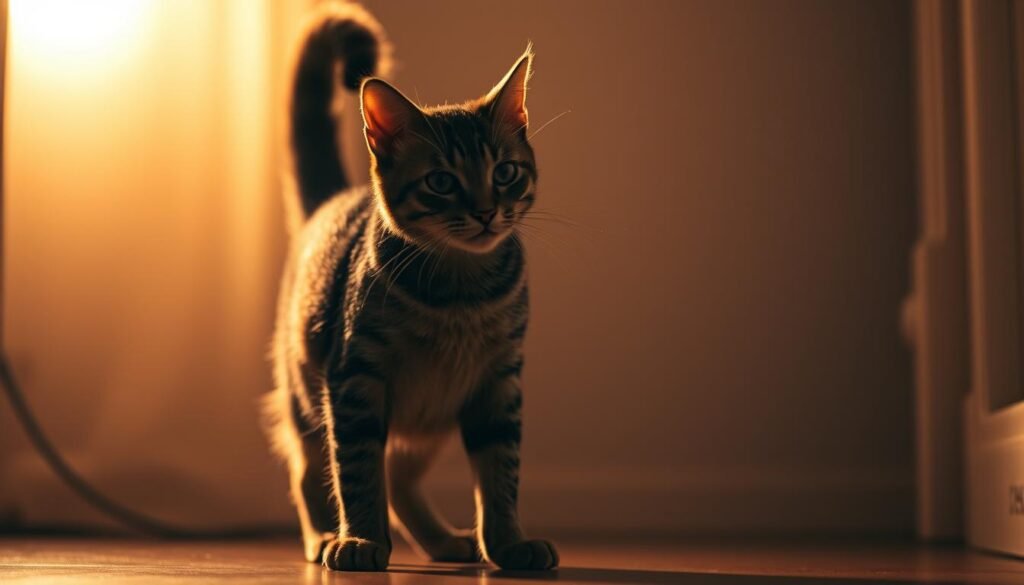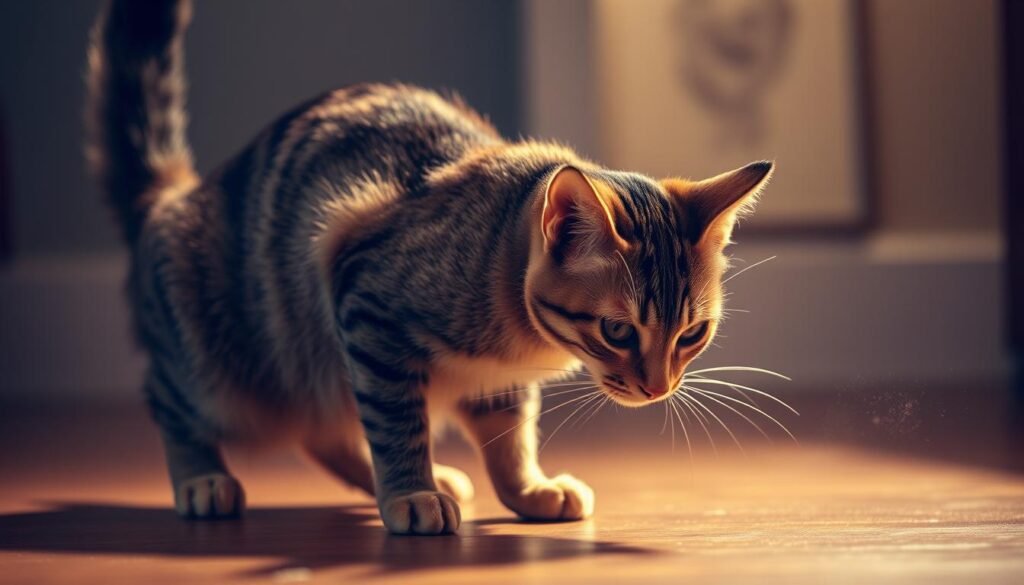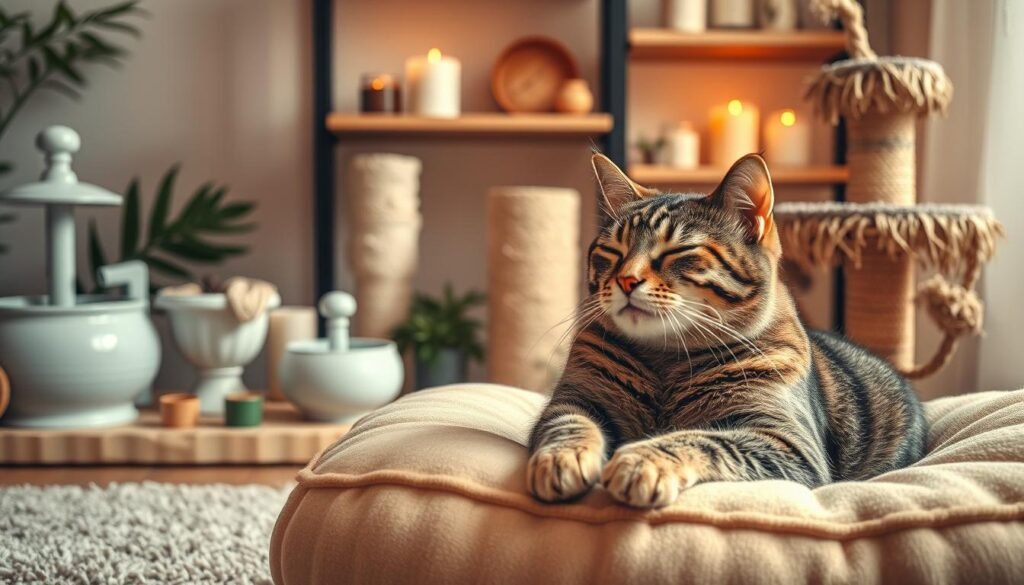
I walked into my living room and smelled something bad. My cat, Whiskers, had sprayed on my favorite armchair. Cat spraying is more than a mess; it’s a sign that something’s wrong.
Cat spraying is not the same as regular urination. It’s a way for cats to talk to us. Knowing why cats spray and how to stop it is key to a good relationship with them. We’ll look at why cats spray and how to fix it.
Key Takeaways
- Cat spraying is a form of communication, not just inappropriate urination
- Both male and female cats can spray, though it’s more common in males
- Stress, anxiety, and territorial issues are major triggers for spraying
- Medical conditions can sometimes cause spraying behavior
- Neutering or spaying can reduce spraying in most cats
- Creating a stress-free environment is key to preventing spraying
- Professional products and veterinary help are available for persistent cases
About 10% of neutered male cats and 5% of spayed female cats spray after being fixed. This shows how complex the issue is. Spraying is more common in intact cats, but it can happen to any cat, at any age.
Understanding cat spraying is the first step to solving this problem. Let’s explore why cats spray and how we can help them communicate better.

Understanding Cat Spraying vs. Normal Urination
Cat spraying is different from normal urination. Knowing the difference helps solve cat behavior problems. Spotting these differences early makes cleaning up cat urine easier.
Physical Signs of Cat Spraying
When a cat sprays, it shows certain signs. It backs up to a wall, raises its tail, and quivers it. This is unlike the squatting for normal urination.
Differences in Urine Composition
Sprayed urine smells stronger. It has more pheromones than regular urine. This scent helps cats mark their territory.
| Characteristic | Normal Urination | Spraying |
|---|---|---|
| Position | Squatting | Standing, tail raised |
| Location | Litter box or horizontal surfaces | Vertical surfaces |
| Amount | Larger volume | Small amount |
| Odor | Less intense | More pungent |
Common Locations for Spraying
Cats spray on vertical surfaces like walls and furniture. They choose these spots to mark territory. Knowing this helps in cleaning up cat urine.
Recognizing these differences helps solve cat behavior problems. Remember, sudden changes in urination habits might mean health issues. Always check with a vet first.

Why You Can’t Ignore Cat Spraying
Cat spraying is a behavior you can’t afford to overlook. About 10-15% of cats spray urine, which signals possible issues. This isn’t just about keeping your home clean – it’s about your cat’s well-being.
Ignoring cat spraying can lead to persistent problems. In multi-cat households, about 30% of cats may spray to establish territory. This behavior often indicates stress, anxiety, or even underlying health concerns. By addressing it promptly, you’re taking a key step in cat behavior modification techniques.
Consider these eye-opening statistics:
- 50% of indoor cat owners report spraying when outdoor cats are present
- 40% of cats may start spraying due to environmental changes
- 60% of cat owners mistake spraying for a medical issue, not a behavioral one
Understanding why you can’t ignore cat spraying is key to maintaining a harmonious household. It’s not just about the odor or stains – it’s about decoding your cat’s silent messages. By tackling this issue head-on, you’re ensuring your feline friend’s comfort and potentially averting more serious problems down the line.

The Science Behind Cat Territorial Marking
Cat territorial marking is a fascinating aspect of feline behavior rooted in biology and instinct. It’s key to understanding why cats sometimes urinate inappropriately. Let’s dive into the science behind this natural yet sometimes problematic behavior.
Pheromone Communication
Cats use pheromones in their urine to communicate with other felines. These chemical substances convey important information about a cat’s identity, reproductive status, and territorial claims. When a cat sprays, it’s leaving a complex message for other cats to interpret.
Natural Instincts and Territory
Territorial marking is deeply ingrained in a cat’s natural instincts. In multi-cat households or when outdoor cats are present, this behavior often intensifies. Studies show that about 10-15% of cats exhibit spraying behavior, with the percentage rising to 30% in homes with multiple cats.
Social Hierarchy Signals
Spraying also serves as a means of establishing social hierarchy among cats. In households with more than one cat, spraying can increase due to territorial disputes. Approximately 40% of cats that spray do so in response to unfamiliar cats in their territory.
| Factor | Percentage |
|---|---|
| Cats exhibiting spraying behavior | 10-15% |
| Spraying in multi-cat households | Up to 30% |
| Spraying due to unfamiliar cats | 40% |
| Neutered males that stil spray | 10% |
| Neutered females that stil spray | 5% |
By understanding these scientific aspects of cat territorial marking, we can develop more effective strategies to manage and redirect this behavior. This can help reduce instances of feline inappropriate urination.

Medical Causes of Cat Spraying
Cat spraying isn’t just about behavior. As a cat owner, I’ve found that health problems can cause it too. Issues like urinary tract infections and bladder stones can make cats uncomfortable. This discomfort leads them to spray outside their litter box.
Spotting these health issues early is key to stopping cat spraying. If your cat’s bathroom habits change suddenly, see a vet. Hormonal imbalances, diabetes, and kidney disease can also lead to spraying. These conditions make cats drink more and go to the bathroom more often.
About 10% of cats face elimination problems. Some cats might stop using the litter box, while others use it less. To solve these problems, it’s important to check for medical causes first.
| Medical Condition | Symptoms | Impact on Spraying |
|---|---|---|
| Urinary Tract Infection | Frequent urination, small amounts | Increased urgency, pain during urination |
| Bladder Stones | Blood in urine, straining to urinate | Discomfort leads to avoiding litter box |
| Feline Interstitial Cystitis | Increased urgency, painful urination | Can cause inappropriate elimination |
By fixing these health issues quickly, we can often stop or lessen spraying. A healthy cat is less likely to spray. Regular vet visits and watching your cat’s health are important steps to prevent spraying and keep your cat well.
Behavioral Triggers for Cat Spraying
Understanding why cats spray is key to stopping it and managing stress in cats. Many things can make cats spray, from feeling upset to changes in their environment.

Stress and Anxiety Factors
Stress is a big reason for cat spraying. A survey showed that 60% of cat owners say their cats spray due to stress or anxiety. This shows how important it is to manage cat stress well.
Environmental Changes
Changes in a cat’s home can make them spray. About 30% of cats spray when they move or get new pets. Even small changes, like moving furniture, can upset a cat.
- Moving to a new home
- Introducing new pets
- Rearranging furniture
- Home renovations
Multi-Cat Household Dynamics
In homes with more than one cat, spraying is a way to mark territory. Studies found that about 50% of cats in these homes spray to mark their area. This is more common in unneutered males, with 80% spraying compared to 10% of neutered males.
To tackle these issues, I suggest making a stress-free space. Keep routines consistent and provide enough for all cats. These steps can help cut down on spraying and make cats happier and healthier.
Do Female Cats Spray? Breaking the Myths

Many think only male cats spray, but that’s not right. Both males and females can spray, but unneutered males do it more often. Knowing this helps cat owners tackle behavior problems better.
Female cats spray for reasons like marking territory or signaling they’re in heat. They might also spray due to stress. Even though it’s less common, female spraying is a problem that can cause urine issues at home.
Spaying or neutering can cut down on spraying. It’s best to do this before they hit puberty, around 5 to 6 months. But, it’s not a complete solution if spraying has become a habit.
- Both male and female cats can spray
- Unneutered males are more likely to spray
- Female cats may spray when in heat or stressed
- Spaying/neutering can help reduce spraying
If you’re facing spraying issues, don’t think it’s just male cats. Keep an eye on all your cats and see a vet if the problem doesn’t go away. Early action is vital in handling cat behavior problems and avoiding urine issues.

The Impact of Spaying and Neutering on Spraying
Spaying and neutering are key ways to change a cat’s behavior and stop spraying. These surgeries can cut spraying by up to 90% if done before a cat reaches sexual maturity.
Optimal Age for Surgery
The best time for neutering is between 4 to 6 months, before a cat’s first heat cycle. Kittens neutered between 8 weeks and 6 months face fewer health risks. They are also less likely to start spraying.
Success Rates After Surgery
Neutering greatly lowers spraying in most cats. Male cats neutered at 5-6 months usually don’t spray. Even older cats see a big drop in marking behaviors after the surgery.
Hormonal Influences
Neutering changes hormones that make cats mark their territory. It lowers testosterone in males, reducing aggression and wandering. For females, spaying stops heat cycles, which can cause spraying.
| Benefit | Male Cats | Female Cats |
|---|---|---|
| Spraying Reduction | Significant decrease | Prevents heat-related spraying |
| Health Benefits | Lower risk of prostate disease | Reduced risk of certain cancers |
| Behavioral Changes | Less aggression and roaming | Elimination of heat-related stress |
While neutering is very effective in stopping cat spraying, some cats might need more help. This is true if they’ve sprayed for a long time. Regular vet visits can help with any ongoing issues after surgery.
Effective Solutions for Stopping Cat Spraying
Cat spraying can be really frustrating. But, there are many ways to stop it. A mix of different methods works best.
First, find out why your cat is spraying. Is it stress, health problems, or fighting over territory? Knowing the reason helps you take the right steps. In homes with more than one cat, make sure each one has its own space. This means having multiple litter boxes, food bowls, and places to rest.
Products like Feliway can make your cat feel calm. This can cut down spraying by half. Always clean up sprayed spots with special cleaners. This removes smells and stops your cat from spraying there again. Rewarding your cat for using the litter box correctly is also helpful.
At times, your vet might suggest anti-anxiety meds. Tools like Cat Spray Stop offer many ways to handle this problem. Always be patient and keep up with these methods.
- Spaying or neutering can reduce spraying by 90% in males and 50% in females
- 10-15% of cats exhibit spraying behavior
- 70% of owners don’t seek professional help for spraying issues
By tackling the main reasons and using these strategies, you can greatly lessen or stop cat spraying at home.

Creating a Stress-Free Environment for Your Cat
A calm home is key for cat stress management and preventing cat spraying. I’ll share some effective strategies to make your cat feel secure and content in their space.
Territory Management
Cats need their own turf. I recommend providing separate resting spots, scratch posts, and high perches for each cat. This helps reduce territorial disputes and spraying behaviors.
Resource Distribution
In multi-cat homes, proper resource placement is key. I follow the “n+1” rule for litter boxes – one more than the number of cats. Food and water stations should be spread out to prevent resource guarding.

Outdoor Cat Prevention
If outdoor cats trigger spraying, I use deterrents like motion-activated sprinklers. Covering windows can also block views that might stress your indoor cat.
| Strategy | Benefits | Implementation Tips |
|---|---|---|
| Multiple Litter Boxes | Reduces spraying by 50% | Place in quiet, accessible areas |
| Separate Resources | Decreases territorial stress | Distribute food, water, and beds throughout the house |
| Environmental Enrichment | Lowers anxiety-related spraying | Provide interactive toys and puzzle feeders |
By implementing these strategies, I’ve seen significant reductions in cat spraying behaviors. A stress-free environment not only prevents spraying but also promotes overall feline well-being.
Professional Products and Treatments
Professional products can change the game when dealing with cat spraying. The right tools can make a big difference in managing this tough behavior.
Pheromone Products
Cat pheromone products help reduce stress-related spraying. They mimic natural cat pheromones, making your cat feel safe. Products like Feliway have shown great results, with a 75% success rate in cutting down spraying.
Cleaning Solutions
Enzymatic cleaners are key for getting rid of cat urine smells. They break down urine components, removing the smell and stopping cats from spraying again. Thorough cleaning is vital to prevent future spraying.
Behavioral Modification Tools
Clicker training and rewards can encourage good behavior. Cat Spray Stop is a program that helps with spraying behavior. It uses behavioral techniques, environmental changes, and natural remedies.
About 80% of cat owners see less spraying after using behavioral changes and enrichment. Many users report big improvements in their cats’ behavior with Cat Spray Stop.
Remember, using professional products is just part of the solution. Combine them with vet care and environmental changes for the best results for you and your cat.

When to Seek Veterinary Help
Cat behavior problems can be hard to fix by yourself. If you’ve tried to stop feline inappropriate urination at home but failed, it’s time to get help from a vet. Veterinary care is essential when spraying doesn’t stop or gets worse.
About 10% of cat owners face urine spraying issues. This behavior is common in unneutered males (80% of intact males spray). But even spayed or neutered cats may spray due to stress or anxiety (15% of cases). Health problems like cystitis or hyperthyroidism are found in 20% of cats with elimination issues.
A vet can do a detailed check to find out if a medical issue is causing the spraying. They might also give advice on behavior or prescribe medication for anxiety. Early action is important to stop bad habits from forming.
If you see any of these signs, make an appointment with your vet:
- Spraying behavior that doesn’t improve with home strategies
- Sudden increase in spraying frequency
- Changes in urination habits or appearance of urine
- Signs of discomfort while urinating
- Other behavioral changes or health concerns
Getting professional help quickly can help solve cat spraying problems. Your vet can help you through the process. They’ll make sure your cat stays healthy and happy.

Conclusion
I’ve looked into cat spraying and how to stop it. This behavior happens in about 10% of cats due to stress or anxiety. It needs a mix of solutions to fix.
Changing cat behavior is key to solving this problem. It can come from health issues, changes in their environment, or wanting to mark their territory.
Stopping cat spraying means making their space calm and clean. It also means taking care of their health. Cats might spray because of infections or even tumors.
Having enough litter boxes is very important. You should have one more than the number of cats you have. This can help a lot.
Being patient and consistent is important when dealing with cat spraying. There are many ways to help, like using special products or spaying/neutering. But remember, every cat is different.
Understanding why they spray and finding the right solution can make a big difference. This way, we can have a better life with our cats.
FAQ
How can I tell if my cat is spraying or just urinating?
A cat spraying backs up to a vertical surface, raises its tail, and releases a small amount of urine. Normal urination happens on horizontal surfaces with the cat squatting. Sprayed urine smells stronger because of extra pheromones.
Can female cats spray?
Yes, female cats can spray, though it’s less common than in males. Both sexes spray for territorial marking, signaling reproductive readiness, or due to stress. Spaying or neutering can greatly reduce this behavior in both genders.
Will spaying or neutering my cat stop the spraying?
Spaying or neutering can cut spraying behavior by up to 90%. It works best before the cat is sexually mature, around 5-6 months. If spraying is a habit, more methods might be needed.
What are some common triggers for cat spraying?
Stress, anxiety, and environmental changes like moving or new furniture are common triggers. New pets or family members and conflicts in multi-cat homes also cause spraying. Medical issues can make spraying worse.
How can I create a stress-free environment to prevent spraying?
Give each cat its own space, including separate resting areas and scratching posts. Use the “n+1” rule for litter boxes and food bowls. Pheromone products, environmental enrichment, and managing conflicts can help. Block outdoor cat views if they stress your cat.
Are there any effective products to stop cat spraying?
Yes, products like Feliway can reduce stress-related spraying. Enzymatic cleaners remove urine odors. Programs like Cat Spray Stop combine behavioral techniques and environmental changes for a holistic approach.
When should I seek veterinary help for my cat’s spraying?
See a vet if spraying doesn’t stop with home efforts, if it’s new or increased, or if you suspect a health issue. Vets can check for health problems and offer advice or medication.
Can cat spraying be a sign of a medical problem?
Yes, spraying can signal urinary tract infections, bladder stones, hormonal imbalances, diabetes, or kidney disease. It’s key to check for these health issues before assuming it’s just behavioral.
How do I clean areas where my cat has sprayed?
Use enzymatic cleaners to break down urine odors. Avoid ammonia-based cleaners, as they can smell like urine and encourage more spraying. Clean thoroughly and repeat if needed to remove the scent.
What’s the science behind cat territorial marking?
Cats use pheromones in their urine to communicate with other cats. They share information about identity, reproductive status, and territorial claims. This behavior is natural for establishing and maintaining territory, often in multi-cat homes or when feeling threatened.
Source Links
- https://www.petmd.com/cat/general-health/cat-spraying-why-cats-do-it-and-how-to-stop-it – Cat Spraying: Why Cats Do It and How to Stop It
- https://www.expertcatcare.com/article/stop-cat-spraying-solutions-and-deterrents-for-marking-cats – How to Stop a Cat Spraying Indoors: Vet Shares 11 Solutions
- https://www.petmd.com/cat/behavior/reasons-your-cat-peeing-outside-litter-box – 6 Reasons Your Cat Is Peeing Outside the Litter Box and How To Stop It
- https://www.cchumanesociety.com/cat-peeing-outside-the-box/ – Cat peeing outside the box
- https://www.thecatbehaviorclinic.com/cat-urinating-outside-litter-box/ – Cat urinating outside the box? | Expert cat behavior advice
- https://homeandroost.co.uk/blogs/cats/cats-spraying?srsltid=AfmBOoqJ1ZeR6urZN1ivKnL-e-ZDy0itCGvdWlYdjP-4dQz2gZZLn-tH – Cats Spraying | Why It Starts and How to Stop it.
- https://www.webmd.com/pets/cats/ss/slideshow-behaviorial-problems-in-cats – Cat Behavioral Problems
- https://www.catster.com/cat-health-care/how-to-stop-cat-from-spraying/ – How to Stop a Cat From Spraying: 8 Vet-Approved Tips – Catster
- https://www.expertcatcare.com/article/cat-peeing-everywhere-causes-and-solutions – Why Cats Pee Outside the Litter Box + How to Stop Them
- https://www.aspca.org/pet-care/cat-care/common-cat-behavior-issues/litter-box-problems – Litter Box Problems
- https://indoorpet.osu.edu/cats/problemsolving/conflict – Conflict Between Cats | Indoor Pet Initiative
- https://homeandroost.co.uk/blogs/cats/cats-spraying?srsltid=AfmBOophA7JIYGNtQsggj6g0RnFqpG7oc2i589Bdml2-hKPLLGl–H8r – Cats Spraying | Why It Starts and How to Stop it.
- https://www.hamiltonanimalhospital.com/outside-box-feline-house-soiling.html – Outside the Box: Feline House Soiling
- https://www.catsluvus.com/cat-boarding-hotel/why-is-my-female-cat-spraying-all-of-a-sudden/?srsltid=AfmBOoq7otvmLU6KZsK-A3XUBS5tpUYvORuQAHyWEqRz25VDsVE07OsQ – Why Is My Female Cat Spraying All Of A Sudden? | Cat Boarding Hotel Laguna, Mission Viejo, Anaheim, Santa Ana, CA | Cats Luv Us
- https://www.petmd.com/cat/general-health/top-10-ways-stop-your-cat-peeing-outside-litter-box – Top 10 Ways to Stop Your Cat from Peeing Outside the Litter Box
- https://www.comfortzone.com/behavior-blog/urine-spraying/why-is-my-cat-peeing-on-my-bed – Why Is My Cat Peeing on My Bed? | Comfort Zone
- https://www.pdsa.org.uk/pet-help-and-advice/pet-health-hub/other-veterinary-advice/cat-neutering-a-guide-to-castration-and-spaying – Cat neutering: a guide to castration and spaying
- https://www.auroraveterinaryhospital.com/site/blog/2023/04/15/cat-neutering-before-after-behavior-recovery – Aurora Veterinary Hospital
- https://www.petmd.com/cat/general-health/cat-neutering-aftercare-everything-you-need-know – Cat Neutering Aftercare: Everything You Need to Know
- https://www.mspca.org/angell_services/top-5-ways-to-redirect-undesirable-behaviors-in-cats/ – Top 5 Ways to Redirect Undesirable Behaviors in Cats
- https://www.purina.co.uk/articles/cats/behaviour/training/spraying-and-marking – Cat Spraying & Marking: How to Stop it | Purina
- https://homeandroost.co.uk/blogs/cats/cats-spraying?srsltid=AfmBOopyzxcMd0-6Zg4u00hKlASMV-pKZ3d9J9MK-U47BHI5hiTGsHL2 – Cats Spraying | Why It Starts and How to Stop it.
- https://www.purina.co.nz/articles/cats/behaviour/training/spraying-and-marking – Cat Spraying & Marking: How to Stop it | Purina
- https://homeandroost.co.uk/blogs/cats/cats-spraying?srsltid=AfmBOooGUT0C-cp0Q8TRpdN_LP3kJrSyVvAOEX0UUi2GhfmJWu31Rdis – Cats Spraying | Why It Starts and How to Stop it.
- https://classactcats.com/blog/the-problem-with-remote-punishment-devices-for-cats/ – The Problem With Remote Punishment Devices For Cats
- https://homeandroost.co.uk/blogs/cats/cats-spraying?srsltid=AfmBOoopDuGmD0QXGPpSG7sGWUPYZD1Huk9l23JvSOawpg9nrpGwHWs2 – Cats Spraying | Why It Starts and How to Stop it.
- https://www.catster.com/cat-behavior/should-i-spray-my-cat-with-water/ – Should I Spray My Cat With Water? 6 Vet-Reviewed Reasons Why You Shouldn’t – Catster
- https://www.petmd.com/cat/behavior/cat-peeing-on-the-bed – 10 Reasons Why Your Cat Is Peeing on the Bed and How To Stop It
- https://www.vin.com/vetzinsight/default.aspx?pId=756&id=6133546 – The Nightmare That is Blocked Cats
- https://educhateur.com/en/errors-urine-outside-litter-box/ – No title found